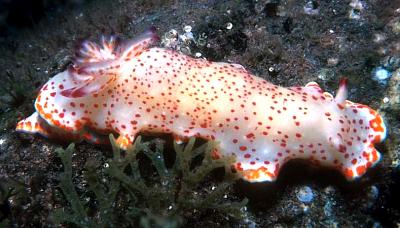
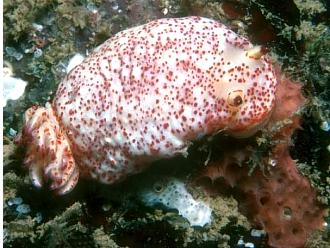
Chromodoris baumanni
Bertsch, 1970
Order: NUDIBRANCHIA
Suborder: DORIDINA
Superfamily: EUDORIDOIDEA
Family: Chromodorididae
DISTRIBUTION
Central Gulf of California to Ecuador, Galapagos Ids.
PHOTO
These animals were all in the 50-60mm range and were photographed at depths of 3-5 meters near Bahia de Concepcion in the Sea of Cortez. Lower photo of animal on probable food sponge. Photos: Scott Johnson.
Translucent creamy yellow with edge of mantle and foot a more opaque white. Mantle covered with red spots, the edge of the notum being encircled with a continuous band of orange dots. Foot banded by orange. Rhinophores white, with a red tip.
Reference:
• Bertsch, H. (1978). The Chromodoridinae Nudibranchs from the Pacific Coast of America – Part II. The genus Chromodoris. The Veliger, 20 (4): 307-327.
Rudman, W.B., 2000 (October 13) Chromodoris baumanni Bertsch, 1970. [In] Sea Slug Forum. Australian Museum, Sydney. Available from http://www.seaslugforum.net/find/chrobaum
Related messages
Chromodoris baumanni laying eggs
January 30, 2004
From: Angel Chiriboga
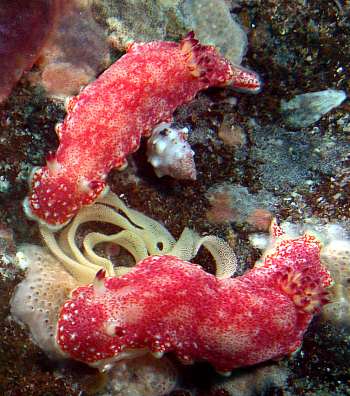
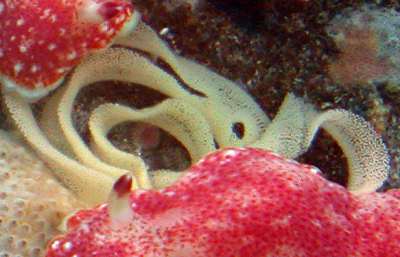
Dear Dr. Rudman,
Here are two Chromodoris that I think they are C. baumanni. What do you think? I found them under a rock (20ft) at Cousins, Santiago Is, Galápagos Ids. They where laying eggs.
I hope you found this interesting.
Best wishes,
Angel Chiriboga
achiriboga@fcdarwin.org.ec
Chiriboga< A., 2004 (Jan 30) Chromodoris baumanni laying eggs. [Message in] Sea Slug Forum. Australian Museum, Sydney. Available from http://www.seaslugforum.net/find/12053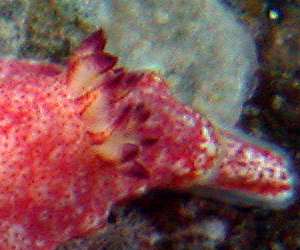
Dear Angel,
Thanks for this interesting photo. It helps record the colour variation in this species and is the first egg mass I have seen of this species. I have included a close-up alongside of the gills of one of your animals as it shows that at least in larger animals the gills are triangular in cross-section. You can see a red-speckled smooth outer face on each gill. This is not apparent on many of the photos on the Forum. [see Alicia Hermosillo's photos.]
Best wishes
Bill Rudman
Chromodoris baumanni from Bahia de Banderas
July 31, 2003
From: Alicia Hermosillo
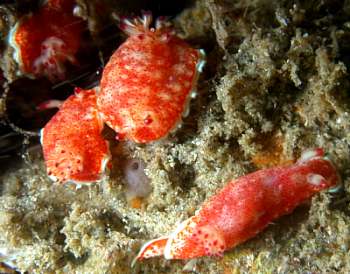
Dear Dr. Rudman,
I am sending you pictures of Chromodoris baumanni from Bahia de Banderas, from Playa Lindomar, [Mexico, Pacific coast] taken on July 21st 2003 (with sponge) and February 23rd 2003 (group photo). Depth around 20 feet, animal lengths between 15 and 28 mm, night dives.
I have observed Chromodoris baumanni in Bahia de Banderas to be a nocturnal critter, found very rarely crawling around during the day.
This particular spot seems to hold the greater abundance of the species. The animal in the picture was feeding on this orange sponge, sorry, I do not know the species, but it is more abundant here than anywhere else in the Bay. The upper picture was a very nice and uncommon occurrence of 4 together.
Cheers!
Alicia
gueri25@hotmail.com
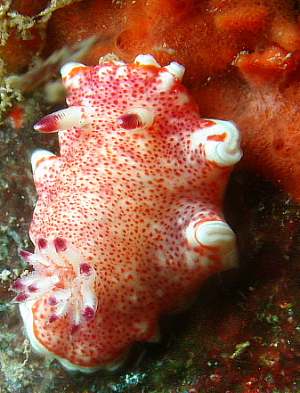
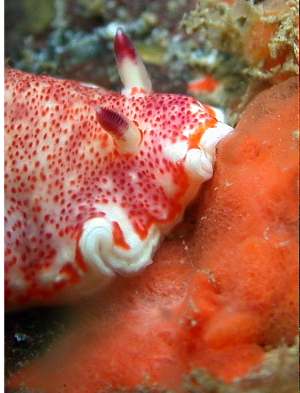
Thanks Ali,
Your contributions are certainly improving our knowledge of the eastern Pacific fauna
Best wishes,
Bill Rudman
Chromodoris baumanni from west Mexico
July 4, 2002
From: Alicia Hermosillo
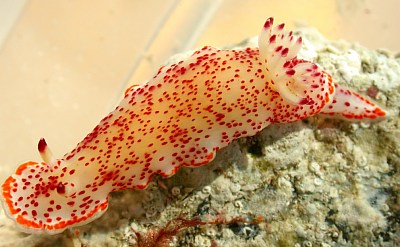
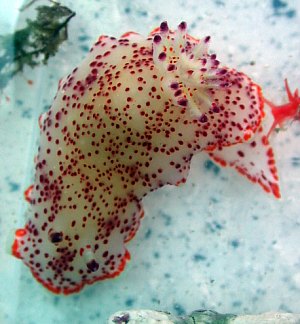
Dear Dr. Rudman,
I found this Chromodoris baumanni inside a sea cave. It was eating a white sponge I can not identify. As you can compare with my prior pictures of the same species, this one looks more like the ones usually published (a lot like the other pictures here in the Forum). The red one I see all the time.
Locality data: El Morro, Bahia de Banderas, Pacific Coast of Mexico, 87 feet deep and 26mm long.
Ali
gueri25@hotmail.com
Hermosillo, A., 2002 (Jul 4) Chromodoris baumanni from west Mexico. [Message in] Sea Slug Forum. Australian Museum, Sydney. Available from http://www.seaslugforum.net/find/7397Thanks Ali,
It is certainly an interesting colour change. If they were found much further apart I would wonder if they were perhaps mimicking different species much as Chromodoris epicuria does in southeastern Australia. But geographic separation is obviously not the reason for the colour differences in Chromodoris baumanni.
Best wishes,
Bill Rudman.
Re: Chromodoris baumanni from Mexico
May 2, 2002
From: Alicia Hermosillo
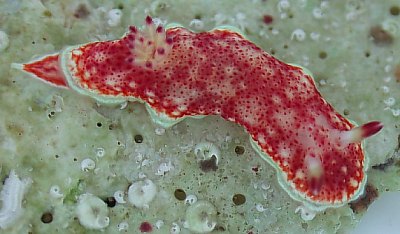
Dear Dr. Rudman,
Thank you for your message about C. marislae. I have to mention I have not seen a T. evelinae as yet around here.
As far as the orange spots species, I have not seen Chromodoris norrisi, C. galexorum or C. annulata which are the likely ones to be found (remember I have been surveying only for 3 months). All C. baumanni I have seen in the area have red spots so close together it is almost a solid color and do not show the orange-red separated spots that some other specimens do.
Locality data for the picture: El Bajo del Cristo, Los Arcos, Bahia de Banderas, Pacific Coast of Mexico. March 17th, 45 feet deep.
Ali
gueri25@hotmail.com
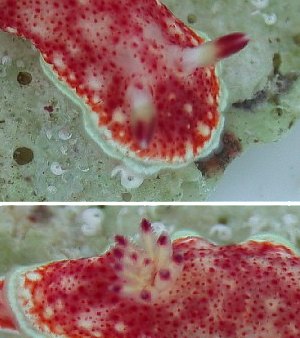
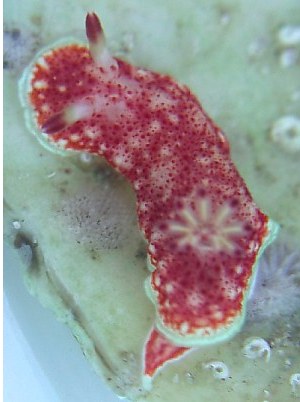
Thanks Ali,
This is an interesting variation in the colour pattern. I am sure the other species will turn up in time. Nudibranchs are notoriously unhelpful when you really want them. I have been moment trying to find one specimen each of two of the most common chromodorids here in Sydney for some months withour success.
I am interested in your mention of Chromodoris annulata. If it does occur in the East Pacific it will be one of the strangest disjunct distributions of any mollusc species. It is usually found in the western Indian Ocean and there are some records along the northern Indian Ocean as far as Thailand. I suspect Alex Kerstitch's record from Isla Tortuga, Gulf of Mexico, may be a mislabelled photograph. I find the alternative idea of an animal being released from an aquarium rather unlikely.
Best wishes,
Bill Rudman
Chromodoris baumanni from the Sea of Cortez
October 15, 2000
From: Scott Johnson

Hi Bill,
I enjoyed Jeff Goddard's photos of Eastern Pacific chromodorids recently posted. The Sea of Cortez certainly has some spectacular species. Attached are three shots of another species, Chromodoris baumanni, showing a bit of variation in color. The LOWER RIGHT photo shows it on what appears to be a prey sponge. These animals were all in the 50-60mm range and were photographed at depths of 3-5 meters near Bahia de Concepcion in the Sea of Cortez.
Scott
johnson@kmr.ll.mit.edu
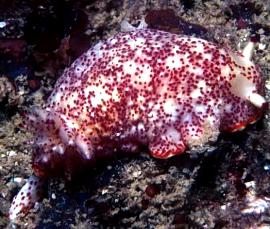

Dear Scott,
Thanks for the photos. The last few days have certainly brought a wonderful collection of chromodorids and other dorids from the East Pacific and the Caribbean.
Bill Rudman.
